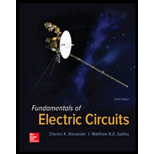
Concept explainers
Find the charge q(t) flowing through a device if the current is:
- (a) i(t) = 3 A, q(0) = 1 C
- (b) i(t) = (2t + 5) mA, q(0) = 0
- (c) i(t) = 20 cos(10t + π/6) μA, q(0) = 2μC
- (d) i(t) = 10e‒30t sin 40t A, q (0) = 0
(a)
Calculate the charge
Answer to Problem 3P
The charge
Explanation of Solution
Given data:
The current flowing through the device
The charge at initial state
Formula used:
Write the expression for charge entering to the device as follows:
Here,
Calculation:
Substitute 3 A for
Conclusion:
Thus, the charge
(b)
Calculate the charge
Answer to Problem 3P
The charge
Explanation of Solution
Given data:
The current flowing through the device
The charge at initial state
Calculation:
Substitute
Conclusion:
Thus, the charge
(c)
Calculate the charge
Answer to Problem 3P
The charge
Explanation of Solution
Given data:
The current flowing through the device
The charge at initial state
Calculation:
Substitute
Conclusion:
Thus, the charge
(d)
Calculate the charge
Answer to Problem 3P
The cha charge
Explanation of Solution
Given data:
The current flowing through the device
The charge at initial state
Calculation:
Substitute
Simplify the expression as follows:
Conclusion:
Thus, the charge
Want to see more full solutions like this?
Chapter 1 Solutions
Fundamentals of Electric Circuits
- A charge of 2 C flowing past a given point each second is a current of 2 A. Select one: True Falsearrow_forwardcurrent of 200a is passed through a stainless-steel wire [k = 19 w/m °c] 3mm in diameter. the resistivity of the steel may be taken as 70 μω.cm, and the length of the wire is 1 m. the wire is submerged in a liquid at 110°c and experiences a convection heat transfer coefficient of 4 kw/m2 °c. calculate the center temperature of the wire.arrow_forwardThe total charge stored on a 1 cm diameter insulating plate is −1013 C. How many Electrons are on the plate? What is the areal density of electrons (number of electrons per square meter) If additional electrons are added to the plate from an external source at the rate of 10^6 electrons per second, what is the magnitude of the current flowing between the source and the plate? Hint: I = dq (in Coulombs) /dt (in Seconds)arrow_forward
- Compute the current, in amperes, at t = 3.56 ms, passing through a point given that the charge in the point is given as q(t) = 7.81e^(-2t) cos(5.05 t) in coulombs.arrow_forwardChemistry Q1)The electrical current can, , pass across the metal-solution interface, although there is no resistance to it A) TRUE B) FALSE Q2) If the maximum efficiency possible for a fuel cell = 70% referring to higher hating value determine the cell voltage E ? a. 0.875 V b. 10. 36 V c. 87.5 V d. 1. 036 Varrow_forwardSuppose we have a washer-shaped object with conductivity 50 S/m. The inner radius is a = 3 mm, the outer radius is b = 7 mm, and the thickness is 1 mm. We apply a voltage 5 V between the inner and outer edges. Calculate the resulting current flow. Provide your answer in Amps to two decimal places ..arrow_forward
- For an electrical component, the formulas for charge and voltage are given below. A is 9 coulombs, B is 12 seconds, C is 3 volts, and D is 24 seconds. Give the total energy of this component from 0 to 4 sec. You must round your answer to the nearest integer and give your answer as an integer followed by the appropriate letter that represents the units of energy.arrow_forward1. A group of 5 x 1016 free electrons passed a point in a conductor in 20 s. Find the current flowing. 2. A water heater has a resistance of 5.5 Ω and draws a rated current of 40 A. Find the kWh consumed in a period of one month if the heater is in service on the average of 1.5 hours per day.arrow_forwardThe total charge entering a terminal is given by q = 2e3t cos (6\pi t), in µC. Determine the current at t= 0.25 s.arrow_forward
- A wire of diameter 1mm and conductivity 5x107 S/m has 1029 free electrons /m3 when an electric field of 10mV/m is applied. Determine: (a) current density (b) current in the wire (c) charge density of free electronsarrow_forwardIn an experiment, a square aluminium bar of 10.5m long and 15mm width is connected to a 1.5v battery at a room temperature (27C). The current trough its ends is measured before and after immersion in boiling water. Determine : a) The resistance of the bar between its ends before immersion. b) The resistance of the bar between its ends after immersion. c) The electric current through the bar between its ends after immersion.arrow_forwardQ 5 A piece of metal has a cross-sectional area of 3 cm and a length of 6 km If the potential difference between its two ends is 120 v, calculate 1- electrical resistance 2- electric current - current density of the electric field where the specific resistance is 2.1 and 6 x 107 *arrow_forward
 Introductory Circuit Analysis (13th Edition)Electrical EngineeringISBN:9780133923605Author:Robert L. BoylestadPublisher:PEARSON
Introductory Circuit Analysis (13th Edition)Electrical EngineeringISBN:9780133923605Author:Robert L. BoylestadPublisher:PEARSON Delmar's Standard Textbook Of ElectricityElectrical EngineeringISBN:9781337900348Author:Stephen L. HermanPublisher:Cengage Learning
Delmar's Standard Textbook Of ElectricityElectrical EngineeringISBN:9781337900348Author:Stephen L. HermanPublisher:Cengage Learning Programmable Logic ControllersElectrical EngineeringISBN:9780073373843Author:Frank D. PetruzellaPublisher:McGraw-Hill Education
Programmable Logic ControllersElectrical EngineeringISBN:9780073373843Author:Frank D. PetruzellaPublisher:McGraw-Hill Education Fundamentals of Electric CircuitsElectrical EngineeringISBN:9780078028229Author:Charles K Alexander, Matthew SadikuPublisher:McGraw-Hill Education
Fundamentals of Electric CircuitsElectrical EngineeringISBN:9780078028229Author:Charles K Alexander, Matthew SadikuPublisher:McGraw-Hill Education Electric Circuits. (11th Edition)Electrical EngineeringISBN:9780134746968Author:James W. Nilsson, Susan RiedelPublisher:PEARSON
Electric Circuits. (11th Edition)Electrical EngineeringISBN:9780134746968Author:James W. Nilsson, Susan RiedelPublisher:PEARSON Engineering ElectromagneticsElectrical EngineeringISBN:9780078028151Author:Hayt, William H. (william Hart), Jr, BUCK, John A.Publisher:Mcgraw-hill Education,
Engineering ElectromagneticsElectrical EngineeringISBN:9780078028151Author:Hayt, William H. (william Hart), Jr, BUCK, John A.Publisher:Mcgraw-hill Education,





